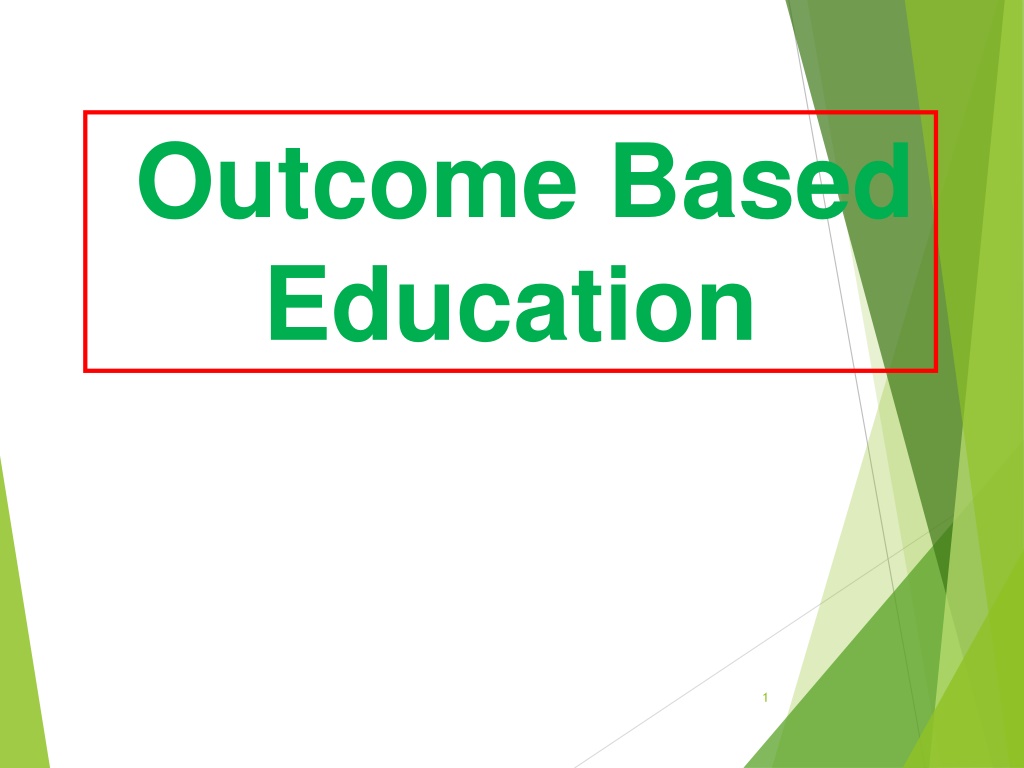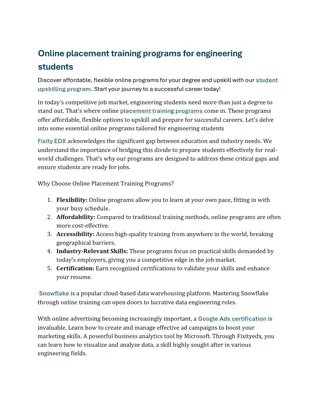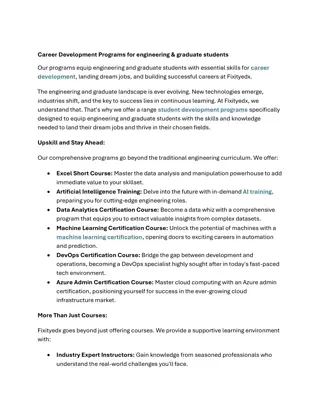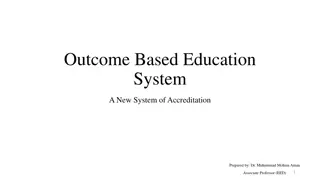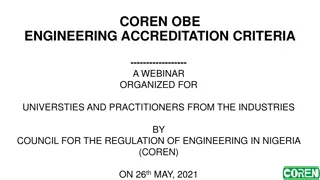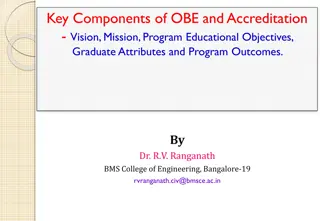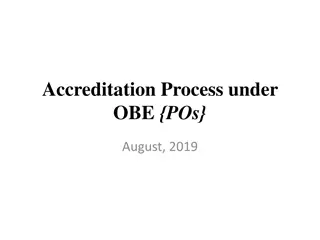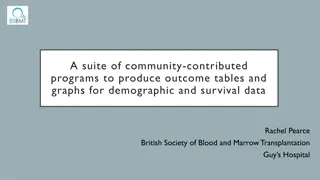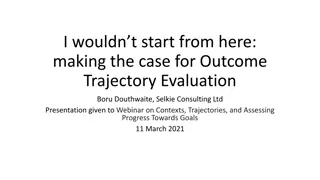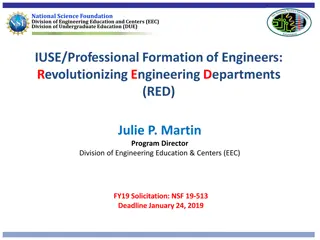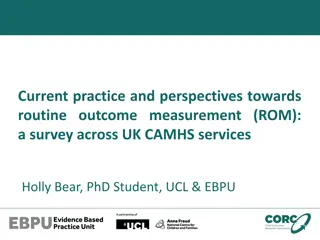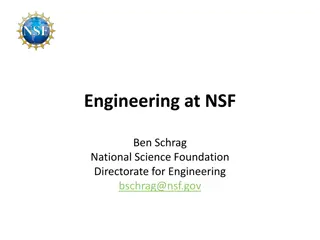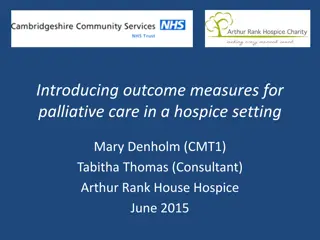Understanding Outcome-Based Education in Engineering Programs
Outcome-Based Education (OBE) focuses on assessing student learning outcomes and program effectiveness in fields like engineering. It aims to produce graduates who meet industry needs, exhibit proficiency in applied knowledge, and demonstrate essential skills and ethical values. OBE involves defining Program Educational Objectives (PEOs), Program Learning Outcomes (PLOs), and Course Learning Outcomes (CLOs) to ensure graduates are well-prepared for their careers. Benefits of OBE include a more relevant curriculum, improved industry relevance, enhanced public relations, better internship opportunities, and continuous quality improvement.
Download Presentation

Please find below an Image/Link to download the presentation.
The content on the website is provided AS IS for your information and personal use only. It may not be sold, licensed, or shared on other websites without obtaining consent from the author. Download presentation by click this link. If you encounter any issues during the download, it is possible that the publisher has removed the file from their server.
E N D
Presentation Transcript
Outcome Based Education 1
OBE => Outcome Based Education OBE => Outcome Based Education Outcome => Output => Result / Product => Outcome => Output => Result / Product => University Product => Performance of Graduates & Alumni University Product => Performance of Graduates & Alumni OBE assessment and evaluation practices in education to reflect the attainment of expected learning and showing mastery in the program area. is a process that involves Program => e.g. Civil Engineering/ Electrical Engineering etc., Students => Learning in a program Graduates => Just passed the program 2 Alumni => Ex-students, now working
Domains of Engineering Program (1) Cognitive => Engineering Knowledge (2) Psychomotor => Skills learnt by moving body parts (3) Affective => Attitude / ethical values / manners ENGINEERING PROGRAM Psychomoto r (Skill S) Cognitive (Knowledge K) Affective (Attitude A) 3
Benefits of OBE 1. More directed & rational curriculum. 2. Graduates will be more relevant to the industry / field. 3. Enhances public relations. 4. Improve avenues for internships and jobs. 5. Continuous Quality Improvement (CQI) is in place. 4
Objectives / Outcomes PEOs => Program Educational Objectives (Assessed from Stake Holders (Alumni etc.) after 4-5 years of graduation) PLOs => Program Learning Outcomes (Assessed from graduates at the time of graduation) CLOs => Course Learning Outcomes (Assessed from students after each course) 5
Program Educational Objectives (PEOs) 1. The graduates have exhibited their proficiency of applying the knowledge (mathematics, science, engineering) & skills (modern tools) to solve at least one complex engineering problem related to civil engineering. 2. The graduates are working as successful civil engineers for socio-economic, environment-friendly development at national and/or international level. 3. The graduates are able to lead and promote the team work to tackle the complex engineering problems. 4. They exhibit good communication skills, high professional ethics, and continuous urge to enhance their knowledge. 6
Program Learning Outcomes (PLOs) At the time of graduation, the graduate must be able to have: S. No PLOs 1 PLO 1 Engineering Knowledge 2 PLO 2 Problem Analysis 3 PLO 3 Design/Development of Solutions 4 PLO 4 Investigation 5 PLO 5 Modern Tools Usage 6 PLO 6 The Engineers and Society 7 PLO 7 Environment and Sustainability 8 PLO 8 Ethics 9 PLO 9 Individual and Team Work 10 PLO 10 Communication 11 PLO 11 Project Mangement 12 PLO 12 Life Long Learning 7 Note: Each student has to achieve passing score in each PLO
Example of CLO - PLO Mapping PLO 1 PLO 2 S. No CLO Description Engineering Knowledge Problem Analysis 1 to describe the physical properties of fluids. 1 2 to analyze stability of floating and submeged bodies. 1 to compute pressure and centre of pressure on submerged surfaces. 3 1 to prepare hydraulic grade lines and energy lines for pipes and open channels. 4 1 to describe devices to measure pressure, velocity and discharges in pipe lines and open channels. 5 1 8
Contents 1) Out Come Based (OBE) Education System 2) Stake Holders for OBE 3) Main Domains of Engineering Program 4) What is Bloom s Taxonomy? 5) Bloom s Taxonomy Quiz 6) Application of Bloom s Taxonomy in Paper Setting 10
Outcome Based Education (OBE) That System of Education in which first we set future Objectives / Outcomes for Students, Graduates and Alumni / Employer, then we assess and evaluate them, and on the basis of evaluation results we continuously improve it. Objectives / Outcomes for: (1) Students => CLOs (2) Graduates => PLOs (3) Alumni / Employer => PEOs 11
Stake Holders for OBE OBE Introduction / dissemination to: 1) Faculty 2) Technical Staff 3) Administrative Staff 4) Students 5) Alumni 6) Employer 7) Parents 12
What is Blooms Taxonomy? Bloom s Taxonomy is a chart of ideas A Taxonomy is an arrangement of ideas or a way to group things together Named after the creator, Benjamin Bloom 13
Blooms Taxonomy You may see the levels organized differently in other charts 14
Who is Dr. Benjamin Bloom?? He was a teacher, thinker, & inventor He worked at a college He created a list about how we think about thinking 1913-1999 15
The levels of thinking There are six levels of learning according to Dr. Bloom Knowledge Comprehension The levels build on one another. The six levels all have to do with thinking. Application Analysis Level one is the lowest level of thinking Synthesis Level six is the highest level of thinking Evaluation 16
New names?? Some people have renamed these levels to make them easier to remember Knowledge- Remembering Comprehension- Understanding Application- Applying Analysis- Analyzing Some people even switch the last two levels around Synthesis- Creating Evaluation- Evaluation 17
1. Knowledge or Remembering observation and recall of information knowledge of dates, events, places knowledge of major ideas Key words: list, define, tell, describe, identify, show, label, state, tabulate, quote, name, who, when, where, etc. 18
2. Comprehension or Understanding understanding information grasp meaning translate knowledge into new context interpret facts, compare, contrast predict consequences Key words: summarize, describe, interpret, distinguish, estimate, differentiate, discuss, extend 19
3. Application or Applying use information use methods, concepts, theories in new situations solve problems using required skills or knowledge Key words: apply, demonstrate, calculate, complete, illustrate, show, solve, examine, modify, classify 20
4. Analysis or Analyzing seeing patterns organization of parts recognition of hidden meanings identification of components Key words: analyze, separate, order, explain, connect, classify, arrange, divide, compare, select, infer 21
5. Evaluation or Evaluating compare and discriminate between ideas assess value of theories, presentations make choices based on reasoned argument make judgments Key words assess, decide, rank, grade, test, measure, recommend, convince, select, judge, discriminate, support, conclude 22
6. Synthesis or Creating use old ideas to create new ones generalize from given facts relate knowledge from several areas predict, draw conclusions Key words: create, design, invent, combine, integrate, modify, rearrange, plan, compose, formulate, prepare, generalize 23
Creating Evaluating Analyzing Applying Understanding Remembering 26 lower order Intermediate Higher order
lower order Intermediate Higher order 27
lower order Intermediate Higher order 28
Sources http://www.coun.uvic.ca/learn/program/hndouts/bloo m.html http://www.teachers.ash.org.au/researchskills/dalton. htm http://oaks.nvg.org/taxonomy-bloom.html http://en.wikipedia.org/wiki/Image:Bloom%27s_Rose.p ng 29
Thank you & Any Questions? 30
